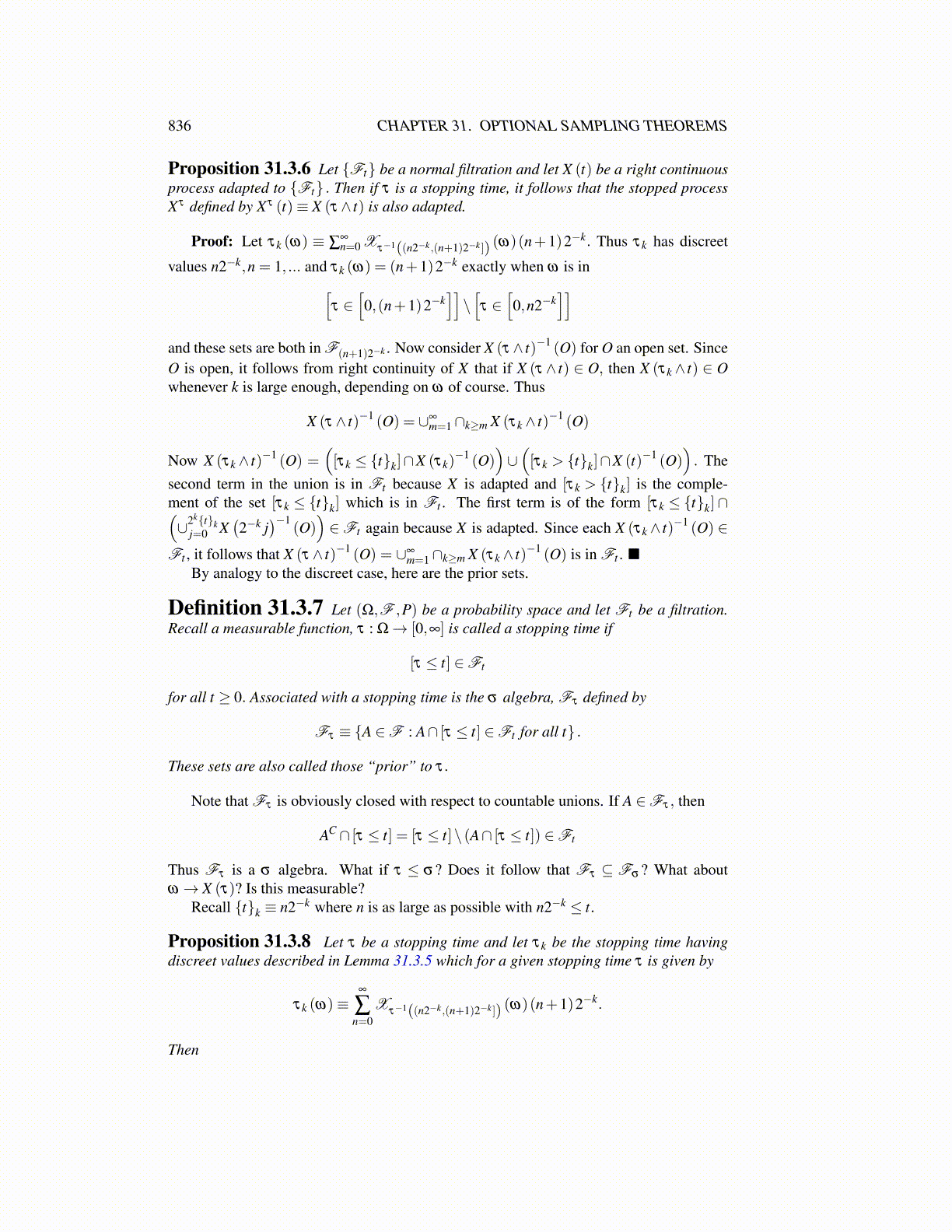
836 CHAPTER 31. OPTIONAL SAMPLING THEOREMS
Proposition 31.3.6 Let {Ft} be a normal filtration and let X (t) be a right continuousprocess adapted to {Ft} . Then if τ is a stopping time, it follows that the stopped processXτ defined by Xτ (t)≡ X (τ ∧ t) is also adapted.
Proof: Let τk (ω) ≡ ∑∞n=0 X
τ−1((n2−k,(n+1)2−k]) (ω)(n+1)2−k. Thus τk has discreet
values n2−k,n = 1, ... and τk (ω) = (n+1)2−k exactly when ω is in[τ ∈
[0,(n+1)2−k
]]\[τ ∈
[0,n2−k
]]and these sets are both in F(n+1)2−k . Now consider X (τ ∧ t)−1 (O) for O an open set. SinceO is open, it follows from right continuity of X that if X (τ ∧ t) ∈ O, then X (τk ∧ t) ∈ Owhenever k is large enough, depending on ω of course. Thus
X (τ ∧ t)−1 (O) = ∪∞m=1∩k≥m X (τk ∧ t)−1 (O)
Now X (τk ∧ t)−1 (O) =([τk ≤ {t}k]∩X (τk)
−1 (O))∪([τk > {t}k]∩X (t)−1 (O)
). The
second term in the union is in Ft because X is adapted and [τk > {t}k] is the comple-ment of the set [τk ≤ {t}k] which is in Ft . The first term is of the form [τk ≤ {t}k]∩(∪2k{t}k
j=0 X(2−k j
)−1(O))∈Ft again because X is adapted. Since each X (τk ∧ t)−1 (O) ∈
Ft , it follows that X (τ ∧ t)−1 (O) = ∪∞m=1∩k≥m X (τk ∧ t)−1 (O) is in Ft . ■
By analogy to the discreet case, here are the prior sets.
Definition 31.3.7 Let (Ω,F ,P) be a probability space and let Ft be a filtration.Recall a measurable function, τ : Ω→ [0,∞] is called a stopping time if
[τ ≤ t] ∈Ft
for all t ≥ 0. Associated with a stopping time is the σ algebra, Fτ defined by
Fτ ≡ {A ∈F : A∩ [τ ≤ t] ∈Ft for all t} .
These sets are also called those “prior” to τ.
Note that Fτ is obviously closed with respect to countable unions. If A ∈Fτ , then
AC ∩ [τ ≤ t] = [τ ≤ t]\ (A∩ [τ ≤ t]) ∈Ft
Thus Fτ is a σ algebra. What if τ ≤ σ? Does it follow that Fτ ⊆ Fσ ? What aboutω → X (τ)? Is this measurable?
Recall {t}k ≡ n2−k where n is as large as possible with n2−k ≤ t.
Proposition 31.3.8 Let τ be a stopping time and let τk be the stopping time havingdiscreet values described in Lemma 31.3.5 which for a given stopping time τ is given by
τk (ω)≡∞
∑n=0
Xτ−1((n2−k,(n+1)2−k]) (ω)(n+1)2−k.
Then